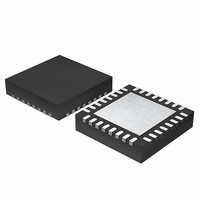EFM32G200F64 Energy Micro, EFM32G200F64 Datasheet - Page 19

EFM32G200F64
Manufacturer Part Number
EFM32G200F64
Description
MCU 32BIT 64KB FLASH 32-QFN
Manufacturer
Energy Micro
Series
Geckor
Datasheets
1.EFM32G200F16.pdf
(63 pages)
2.EFM32G200F16.pdf
(10 pages)
3.EFM32G200F16.pdf
(463 pages)
4.EFM32G200F16.pdf
(136 pages)
Specifications of EFM32G200F64
Core Processor
ARM® Cortex-M3™
Core Size
32-Bit
Speed
32MHz
Connectivity
EBI/EMI, I²C, IrDA, SmartCard, SPI, UART/USART
Peripherals
Brown-out Detect/Reset, DMA, POR, PWM, WDT
Number Of I /o
24
Program Memory Size
64KB (64K x 8)
Program Memory Type
FLASH
Ram Size
16K x 8
Voltage - Supply (vcc/vdd)
1.8 V ~ 3.8 V
Data Converters
A/D 4x12b, D/A 1x12b
Oscillator Type
External
Operating Temperature
-40°C ~ 85°C
Package / Case
32-VQFN Exposed Pad
Processor Series
EFM32G200
Core
ARM Cortex-M3
Data Bus Width
32 bit
Data Ram Size
16 KB
Interface Type
I2C, UART
Maximum Clock Frequency
32 MHz
Number Of Programmable I/os
24
Number Of Timers
2
Operating Supply Voltage
1.8 V to 3.8 V
Maximum Operating Temperature
+ 85 C
Mounting Style
SMD/SMT
Minimum Operating Temperature
- 40 C
Lead Free Status / RoHS Status
Lead free / RoHS Compliant
Eeprom Size
-
Lead Free Status / Rohs Status
Details
Available stocks
Company
Part Number
Manufacturer
Quantity
Price
- EFM32G200F16 PDF datasheet
- EFM32G200F16 PDF datasheet #2
- EFM32G200F16 PDF datasheet #3
- EFM32G200F16 PDF datasheet #4
- Current page: 19 of 463
- Download datasheet (8Mb)
5.3.1.1 Writing
5.3.1.2 Reading
2010-09-06 - d0001_Rev1.00
Every Low Energy Peripheral has one or more registers with data that needs to be synchronized
into the Low Energy clock domain to maintain data consistency and predictable operation. Due to
synchronization, the write operation requires 3 positive edges of the clock of the Low Energy Peripheral
being accessed. Such registers are marked "Asynchronous" in their description header.
See Figure 5.2 (p. 19) for an overview of the writing operation.
After writing data to a register which value is to be synchronized into the Low Energy clock domain, a
corresponding busy flag in the <module_name>_SYNCBUSY register (e.g. RTC_SYNCBUSY) is set.
This flag is set as long as synchronization is in progress and is cleared upon completion.
Note
Figure 5.2. Write operation to Low Energy Peripherals
When reading from a Low Energy Peripheral, the data read is synchronized regardless if it originates
in the Low Energy clock domain or core clock domain. Registers which are updated/ maintained by the
Low Energy Peripheral are read directly from the Low Energy clock domain. Registers which originate in
the core clock domain, are read from the core clock domain. See Figure 5.3 (p. 20) for an overview
of the reading operation.
Note
Write[ 0:n]
Subsequent writes to the same register before the corresponding busy flag is cleared is not
supported. Write before the busy flag is cleared may result in undefined behavior.
In general the SYNCBUSY register only needs to be observed if there is a risk of multiple
write access to a register (which must be prevented). It is not required to wait until the
relevant flag in the SYNCBUSY register is cleared after writing a register. E.g can EM2 be
entered directly after writing a register.
Writing a register and then immediately reading the new value of the register may give the
impression that the write operation is complete. This may not be the case. Please refer
to the SYNCBUSY register for correct status of the write operation to the Low Energy
Peripheral.
Set 0
Set 1
Set n
Core Clock Dom ain
Core Clock
Syncbusy Register 0
Syncbusy Register 1
Syncbusy Register n
Register 0
Register 1
Register n
.
.
.
.
.
.
Clear 0
Clear 1
Clear n
Freeze
...the world's most energy friendly microcontrollers
19
Synchronization Done
Low Frequency Clock
Synchronizer 0
Synchronizer 1
Low Frequency Clock Dom ain
Synchronizer n
.
.
.
www.energymicro.com
Low Frequency Clock
Register 0 Sync
Register 1 Sync
Register n Sync
.
.
.
Related parts for EFM32G200F64
Image
Part Number
Description
Manufacturer
Datasheet
Request
R

Part Number:
Description:
KIT STARTER EFM32 GECKO
Manufacturer:
Energy Micro
Datasheet:

Part Number:
Description:
KIT DEV EFM32 GECKO LCD SUPPORT
Manufacturer:
Energy Micro
Datasheet:

Part Number:
Description:
BOARD PROTOTYPING FOR EFM32
Manufacturer:
Energy Micro
Datasheet:

Part Number:
Description:
KIT DEVELOPMENT EFM32 GECKO
Manufacturer:
Energy Micro
Datasheet:

Part Number:
Description:
MCU, MPU & DSP Development Tools TG840 Sample Kit
Manufacturer:
Energy Micro
Datasheet:

Part Number:
Description:
MCU, MPU & DSP Development Tools TG Starter Kit
Manufacturer:
Energy Micro
Datasheet:

Part Number:
Description:
MCU, MPU & DSP Development Tools TG108 Sample Kit
Manufacturer:
Energy Micro

Part Number:
Description:
MCU, MPU & DSP Development Tools TG210 Sample Kit
Manufacturer:
Energy Micro
Datasheet:

Part Number:
Description:
MCU, MPU & DSP Development Tools TG822 Sample Kit
Manufacturer:
Energy Micro
Datasheet:

Part Number:
Description:
MCU, MPU & DSP Development Tools TG230 Sample Kit
Manufacturer:
Energy Micro

Part Number:
Description:
SAMPLE KIT (SMALL BOX - CONTAINING 2 DEVICES)
Manufacturer:
Energy Micro

Part Number:
Description:
SAMPLE KIT (SMALL BOX - CONTAINING 2 DEVICES)
Manufacturer:
Energy Micro











